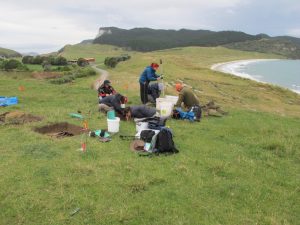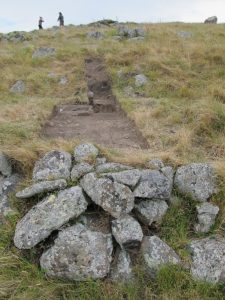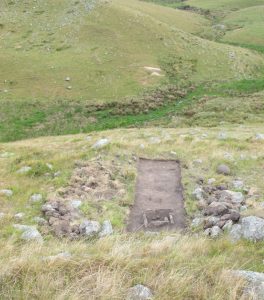At the end of November 2012 a small group of archaeologists spent a week on Great Mercury Island. The intention was to carry out small excavations on the two sites selected for excavation by the Fieldschool in February 2013, to learn about the stratigraphy (layers) and whether any features were present.
The ridge overlooking the tombolo in the centre of the island, named Stingray Ridge, had stone flakes and fire cracked rocks (resulting from being heated in cooking fires) eroding down the south facing slope. The ridge surface had a gentle slope to the west and south which would have been quite suitable for living on, and had the benefit of a good view over the tombolo and sea approaches on east and west sides of the island. Six 1 x 1 m squares were excavated and stone flakes, fire cracked rocks, several postholes and a drain were uncovered. There were two separate occupations present. Where drains similar to this have been found on other sites they usually are associated with channeling water away from semi-subterranean storage pits where kumara tubers were stored. The site looks very promising for excavating a large area over the summer.
Meanwhile the other team were at Tamawhera, the large garden site in the northwest part on the island. Naturally occurring stone boulders had been shifted to form stone rows dividing the north-facing slope of the valley into long strips. There were also narrow terraces on the upper part of the slope, and on the ridge top single alignments of stone and broad terraces with stone-faced front scarps. Narrow trenches were excavated across several of these ridgetop terraces, and across two terraces on the slope. The ridge top terraces had no stone flakes but there was very deep topsoil. We think that the soil had been gardened and that the stones on the front edge of the terraces acted as a retaining wall, allowing more soil to be built up within the gardens.
The narrow terraces produced different evidence. We don’t know what we will find under the grass surface and sometimes archaeologists are lucky and place the test trench in the best possible place to interpret the terrace. In this case on each terrace a stone enclosed hearth was found, and stone flakes. Stone enclosed hearths, usually found within houses, are rare on the Coromandel Peninsula, and very few well-defined houses have been excavated in this region. We look forward to uncovering the entire surface of both terraces in summer to learn about the size of the houses and how sturdy they were.
The conditions at the two locations in late November were very different. The archaeologists on Stingray Ridge, which is very exposed, were well dressed in multiple layers of clothing to stay warm in the cool westerly winds. The lucky people at Tamawhera, protected from the wind, were too hot!! It’s difficult to please everyone all the time.
– Louise




